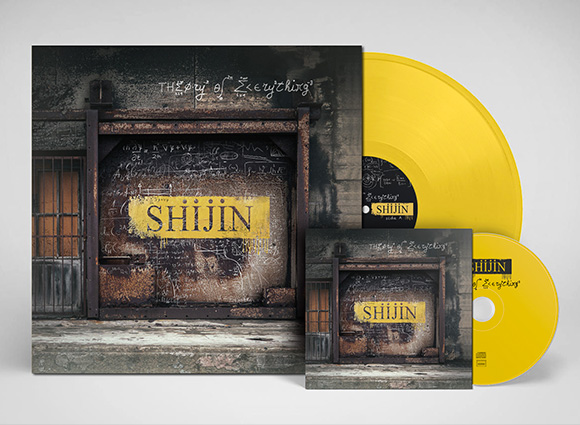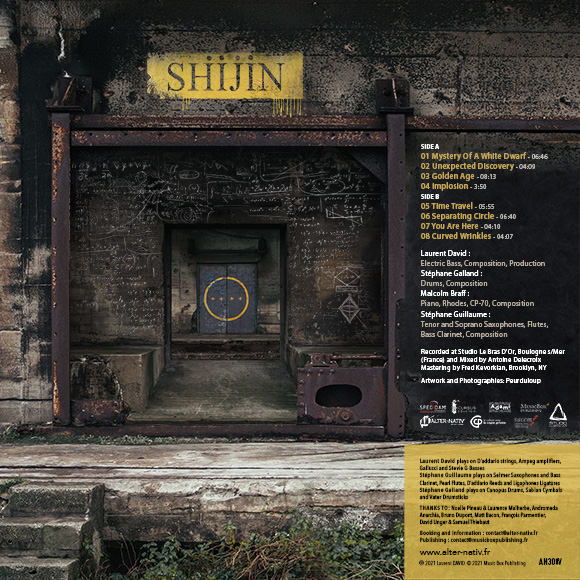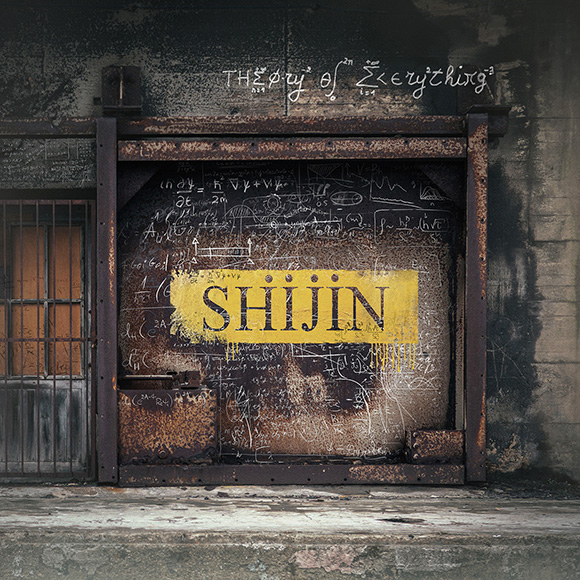scroll down for the english translation
Dans le cadre de la sortie de « Theory of Everything » nous avons interrogé le graphiste et photographe du label, François Parmentier (alias peurduloup) sur son travail pour la pochette de l’album.
Peux-tu nous expliquer comment s’est déroulé ta collaboration avec Shijin pour la pochette de ce nouvel album ?
Pour ce projet j’ai eu la chance d’assister aux séances d’enregistrement au studio à Boulogne sur mer. C’est super intéressant de pouvoir se plonger pleinement dans la musique du quartet pendant quelques jours. Il y a un côté immersif qui permet d’appréhender le processus créatif du groupe. C’était un peu l’idée de Laurent, de réunir tout le monde sur 4 jours et d’avancer sur les différents pans du projet. La musique bien évidemment mais aussi les photos, le graphisme, les vidéos, la promo…
J’ai fait pas mal de photos en studio, qui ont surtout été diffusées pour la promo sur les réseaux sociaux.
Quel a été le processus de création pour la pochette ? Y a t’il eu un travail de préparation ?
Pour la pochette, on avait pas mal discuté en amont avec Laurent et évoqué différentes pistes sans s’arrêter sur une idée précise. « Theory of Everything » ! Le sujet est tellement vaste et porteur. Je suis donc arrivé à Boulogne sans savoir précisément ce que j’allais faire.
Et comment est née l’idée ?
Il y a toujours un coté intuitif dans mon travail mais j’avais quand même fait du repérage sur google map (période de confinement oblige) pour trouver un lieu de shooting proche du studio pour faire les photos de groupe et les portraits de musiciens.
Une fois sur place, je me suis rendu seul devant le bâtiment que j’avais repéré sur les docks pour m’assurer qu’il correspondait bien à ce que j’avais vu sur Google map et éviter les mauvaises surprises. C’était encore mieux que ce que j’avais imaginé ! La bâtisse, une sorte de vieux hangar maritime, présentait 4 façades bien différentes et toutes intéressantes graphiquement avec des matières patinées comme je les aime. Il y avait aussi ces différentes portes, imposantes et un peu mystérieuses. J’ai tout de suite senti qu’il y avait un truc à faire avec ça pour la pochette et j’ai donc pris le temps de les photographier soigneusement.
Symboliquement ça collait avec l’idée que je me faisais de la « Théorie du tout »
L’après-midi on a fait toutes les photos de groupe devant ce même bâtiment qui a servi de décor. On retrouve quelques portraits dans la pochette gatefold du CD au format digifile.
Comment as tu exploité ces éléments pour en faire la pochette ?
De retour chez moi j’ai travaillé à partir des images des portes que j’avais ramenées. J’ai ajouté les formules physiques manuscrites qui représentent un peu le travail de tous ces physiciens qui se sont acharnés à découvrir cette formule sans jamais parvenir à « ouvrir la porte ».
Pour le dos du vinyle on avait d’abord imaginé « ouvrir » la porte et révéler la Theory of everything qui se trouvait derrière mais on a su rester humble (rires). De toute évidence, derrière la porte se trouvait une autre porte ! J’ai travaillé à partir des images de toutes les portes du bâtiment de Boulogne que j’ai imbriquées en enfilade dans photoshop. J’aime l’idée d’avoir respecté la règle des unités un peu comme au théâtre. La pochette est entièrement conçue à partir des éléments recomposés d’une unique et même bâtisse. Et on a tous travaillé au même moment et dans un même lieu pour faire la musique, les portraits, la pochette. Au final on ne sait pas si on se retrouve derrière la porte ou si on s’est retourné pour regarder les portes qui ont été ouvertes, le chemin que l’on a déjà parcouru. Cette idée de portes et d’imbrication correspondait bien à mon sens à la façon singulière de composer du quartet dont les titres ont d’abord été conçus en duo, (basse-batterie et piano-sax) comme des portes ouvertes aux deux autres musiciens qui sont venus compléter le morceau et en faire un tout super cohérent.

(EN) For the release of ‘Theory of Everything’ we interviewed graphic designer & photographer François Parmentier (aka peurduloup) about his work on the cover
Can you explain to us how your collaboration with Shijin went for the cover of this new album?
For this project I had the chance to attend the recording sessions at the studio in Boulogne sur mer. It’s super interesting to be able to fully immerse yourself in the music of the quartet for a few days. There is an immersive side that allows you to understand the group’s creative process. It was a bit like Laurent’s idea, to bring everyone together over 4 days and move forward on the different parts of the project. The music of course but also the photos, the graphics, the videos, the promo …
I took quite a few photos in the studio, which were mainly broadcast for the promotion on social networks.
What was the creative process for the cover? Was there any preparation work?
For the cover, we had discussed a lot beforehand with Laurent and mentioned different avenues without stopping on a specific idea. « Theory of Everything »! The subject is so vast and meaningful. So I arrived in Boulogne without knowing exactly what I was going to do.
And how did the idea come about?
There is always an intuitive side to my work but I still did some scouting on google map (period of confinement required) to find a shooting location near the studio to take group photos and portraits of musicians.
Once there, I went alone in front of the building that I had spotted on the docks to make sure that it corresponded to what I had seen on the Google map and to avoid unpleasant surprises. It was even better than I had imagined! The building, a kind of old maritime hangar, presented 4 very different facades and all graphically interesting with patinated materials as I like them. There were also these different doors, imposing and a little mysterious. I immediately felt that there was something to do with that for the cover and so I took the time to photograph them carefully.
Symbolically it stuck with the idea I had of the « Theory of Everything »
In the afternoon we took all the group photos in front of the same building that served as the backdrop. There are some portraits in the gatefold cover of the CD in digifile format.
How did you use these elements to make the cover?
Back home I worked from the images of the doors I had brought back. I added the handwritten physical formulas which somewhat represent the work of all these physicists who have strived to discover this formula without ever succeeding in « opening the door ».
For the back of the vinyl, we first imagined « opening » the door and revealing the Theory of everything behind it, but we were able to remain humble (laughs). Obviously behind the door was another door! I worked from the images of all the doors in the Boulogne building that I nested in a row in photoshop. I like the idea of having respected the rule of units a bit like in the theater. The cover is entirely designed from the reconstructed elements of a single and same building. And we all worked at the same time and in the same place to make the music, the portraits, the cover. In the end, we don’t know if we are behind the door or if we have turned around to look at the doors that have been opened, the path we have already traveled. This idea of doors and interweaving corresponded well in my opinion to the singular way of composing of the quartet whose titles were first conceived in duet, (bass-drums and piano-sax) like doors open to the two other musicians. who came to complete the song and make it a super cohesive whole.






